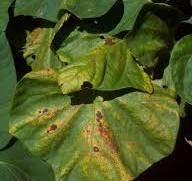In my last article I went over the macro nutrients, this time were downsizing to micro nutrients. These micro nutrients are chloride (Cl) boron (B), copper (Cu), iron (Fe), manganese (Mn), zinc (Zn), molybdenum (Mo) and nickel (Ni). These are like the final toppings of the salad, sure lettuce and dressing are okay, but if you add blueberries, oranges, nuts, red onion, carrot, cucumber, etc. then that’s a SALAD and makes it so much more vibrant and healthy. Although micro in quantity they have macro effects on plants. All numbers will be in parts per million or ppm. Thanks for joining me and lets dig in!
Chloride contributes to over all plant growth, specifically with regards to photosynthesis, which in turns helps with crop productivity. This is of course a micro nutrient so there is the consideration of chloride toxicity, so it’s a rather fine line, dam picky plants. Chlorosis shows in the premature yellowing and the tips of the leaves will brown and die off completely. The target range is 6 to 15 ppm for your soil.
The function of boron in plants is to regulate hormone levels, it’s those dam teenagers *shakes cane at sky*!! Lack of boron will show in stunted growth and misshapen fruit. The overall plant will appear healthy but won’t fruit due to the lack of boron. A proper balance helps absorb the calcium. The target range is 4 to 80 ppm.
Enzymatic activities in plants require copper; chlorophyll production and seed production being of significance. You will want those seeds so you can grow more food later or starve, up to you! A deficiency in copper can lead to lower protection against disease. A high pH (7.5), typically pH is 5.5 to 6.5, but some plants like to be difficult so research individual plants. A copper deficiency will affect vitamin A production. Your target is about 30 ppm.
The nutrient iron plays a key role in the synthesis of chlorophyll, maintaining the chloroplast structures and functions. When pH is too high or too low, iron becomes bound together and slows the travelling of nutrients. Similar to how humans get clogged arteries. Iron deficiency is visible due to signs of chlorosis. The level can be as low as 11 and as high 350 ppm, it varies heavily on the crop you are growing.
Manganese is important in helping sustain metabolic rates within different cell compartments ensuring proper growth rates and development. One specific area it helps with, that I think is important to understand is it helps in the elongation of roots. The farther the roots reach out the more nutrients it will pick up from the soil. From the bottom to the top, we’re here, manganese helps in pollen tube growth and pollen germination. Target amount is 20 to 200 ppm.
Zinc works together with numerous enzyme that are responsible for driving metabolic reactions. In humans it would be like the metabolism that utilizes what it can and expels excess, well before we started waaaaaaay over consuming. A zinc deficiency will reduce formation of carbohydrates, protein and chlorophyll aka the plants energy. The target range is 20 to 100 ppm.
Molybdenum enables the uptake of the macro nutrient nitrogen from the soil by changing the nitrogen into more usable form. Small amounts are needed for normal plant development. This element along with nickel are the two lowest amounts for micro nutrients. A deficiency will look similar to nitrogen deficiency as ultimately that’s what is occurring. Your target is between 2.0 to 5.0 ppm.
Nickel is a component in the enzyme urease, which metabolizes urea nitrogen which then converts into a usable form of ammonia. If nickel isn’t present the urea will gather and essentially choke the plant slowly, but surely. With nickel we are talking 1.1 ppm, that isn’t a whole lot.
Now that we’ve gone over all the nutrients, both macro and micro, in my next article I will be going over watering and how to check moisture, nutrient levels and pH of your soil to give you plants the best chance of success.









